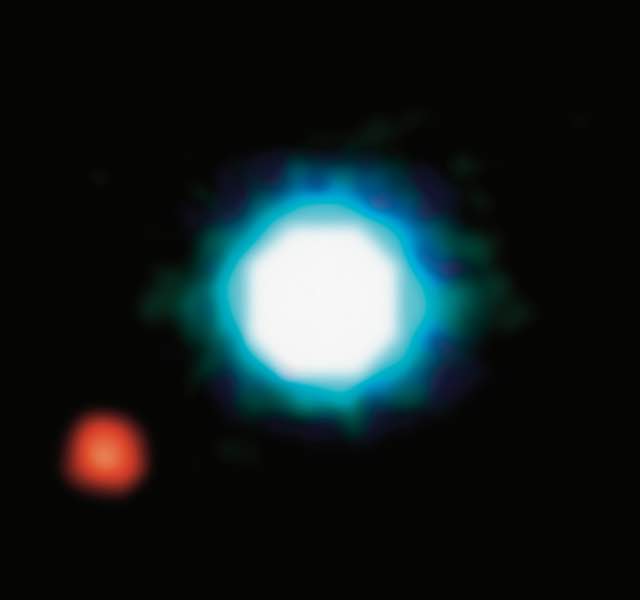This site contains affiliate links to products. I may receive a commission for purchases made through these links.
Over 4,000 exoplanets have been discovered, each orbiting a star beyond our own solar system. This staggering number marks just the beginning of what could be an infinite universe filled with diverse planetary bodies.
Finding exoplanets is achieved through two main categories of detection methods. Direct methods involve the challenging yet feasible task of observing exoplanets near stars using advanced ground-based telescopes or space telescopes. On the other hand, the more commonly employed indirect methods rely on analyzing various data from stars to infer the presence of exoplanets.
These techniques, including the transit method and radial velocity, interpret subtle signals and changes in stellar properties to reveal these elusive worlds.
In this article, learn more about these techniques and methods used by scientists to detect these distant and enigmatic exoplanets.
Direct imaging methods to detect exoplanets: Explored by scientists

The direct imaging method, used to detect exoplanets, faces a significant challenge: exoplanets are typically faint, while the stars they orbit are exceedingly bright. This stark contrast in brightness makes it difficult to discern planets by merely pointing a telescope at a star. Despite these challenges, direct imaging has successfully captured images of exoplanets, with the first groundbreaking image released in 2004.
This milestone image, credited to the Very Large Telescope array (VLT), depicted a composite view of the brown dwarf 2M1207 and its companion planet 2M1207b, located 230 light-years away. It marked not only the first visual evidence of an exoplanet but also the first discovery of a planet orbiting a brown dwarf. The planet, 5 times the mass of Jupiter, was relatively more visible due to its young age and resultant glowing heat, especially in the infrared spectrum. The lower mass of the brown dwarf also contributed to the favorable conditions for capturing this image.
Since then, numerous other exoplanets, primarily large gas giants bigger than Jupiter, have been imaged. The coronograph method is commonly employed for this purpose. A coronograph uses an occulting disk within the telescope to block out the star’s light, allowing only the star’s corona to be visible – a concept akin to a solar eclipse, where the moon obscures the Sun, revealing only a thin ring of light. This technique enables the observation of faint planets orbiting around the star.
However, ground-based telescopes still face limitations due to Earth’s atmosphere, which can distort the light and hinder observations. Although advanced adaptive optics systems are used to compensate for atmospheric light distortion, they are not flawless.
Consequently, telescopes positioned in Earth’s orbit are considered optimal for the direct imaging method, offering clearer and more detailed views of these distant worlds.
Observing exoplanets with optical interferometry

Observing exoplanets with optical interferometry involves a sophisticated technique that combines the light from multiple telescopes to create a virtual super-telescope with enhanced resolution. This method was exemplified by the GRAVITY instrument on the Very Large Telescope Interferometer (VLTI), which achieved the first direct observation of an exoplanet using optical interferometry.
In this particular case, the exoplanet HR8799e was observed, a ‘super-Jupiter’ located approximately 129 light-years from Earth. The high resolution and sensitivity of the VLTI, achieved through interferometry, allowed for the precise separation of light from HR8799e’s atmosphere and its parent star.
This technique enabled the revelation of intricate details of HR8799e’s atmosphere, including clouds of iron and silicates indicative of a planet-wide storm, and a surprising composition of carbon monoxide over methane. This detailed spectrum, offering ten times more detail than previous observations, showcased the potential of optical interferometry in enhancing our understanding of exoplanetary atmospheres and their compositions.
StarShade exoplanet mission
The Starshade mission, proposed by NASA, envisions launching a space telescope accompanied by a uniquely designed, flower-shaped occulter. This occulter is intended to fly in formation with the telescope, precisely positioning itself between the telescope and a targeted star.
By blocking the star’s light, similar to a coronograph but on a much larger scale in space, the Starshade would allow the telescope to directly image exoplanets, including Earth-like planets.
This capability to image smaller, Earth-like exoplanets is currently beyond the reach of ground-based telescopes, making the Starshade mission a significant leap forward in exoplanet exploration.
Indirect methods to detect exoplanets: A pathway for amateur astronomer contributions
While direct methods of detecting exoplanets are undoubtedly groundbreaking, indirect methods are currently more efficient and have led to the discovery of a larger number of exoplanets. These techniques not only enable professional astronomers to uncover new worlds but also open the door for amateur astronomers and citizen scientists to participate in exoplanet detection from their own homes.
With the right approach and without the need for expensive equipment, enthusiasts can significantly contribute to this exciting field of science.
Let’s delve into the various indirect methods used for detecting exoplanets, offering insight into how even amateurs can get involved in this fascinating pursuit.
Reflexive motion detection method

The reflexive motion detection method capitalizes on the subtle gravitational interactions between a star and its orbiting planet. In this celestial dance, the planet’s gravitational force, albeit minimal, causes the star to exhibit a slight wobbling motion rather than remaining perfectly stationary.
This wobble, characterized by the star-making minuscule circular movements, is extremely challenging to observe directly due to its diminutive scale.
However, this motion can be effectively detected through Doppler spectroscopy, a technique that measures the changes in the star’s light spectrum caused by its movement, offering insights into the presence of an orbiting exoplanet.
Doppler spectroscopy – Radial velocity method to detect exoplanets

Doppler spectroscopy, also known as the radial velocity method, is a technique for detecting exoplanets by observing the reflexive motion of a star. This method involves analyzing the star’s spectrum to identify shifts caused by the star’s motion toward and away from us. As the star moves away, its spectrum exhibits a redshift, and conversely, a blue shift when it approaches.
This method gained prominence with the discovery of 51 Pegasi b in 1995 by Michel Mayor and Didier Queloz. It remains one of the most effective methods for identifying exoplanets.
However, it primarily estimates the minimum mass of the planet, as it cannot precisely determine the actual mass of the orbiting body.
Exoplanet detection with transit photometry method

Transit photometry is a powerful and accessible method for detecting exoplanets, one where even amateur astronomers can make significant contributions.
This method involves measuring the light intensity from a star using photometry. When an exoplanet passes in front of its host star along our line of sight, it causes a slight but noticeable dip in the star’s brightness. Although it might seem that such transits would be rare, this isn’t the case.
The Kepler Space Telescope, for example, observed approximately 150,000 stars in the Cygnus constellation and identified thousands of potential exoplanets. This indicates that many exoplanetary systems align favorably with our observational perspective, making transit photometry a surprisingly effective method for discovering new exoplanets.
Kepler space telescope – The pioneering exoplanet hunter
Launched in March 2009, the Kepler Space Telescope embarked on a mission to uncover exoplanets, focusing particularly on Earth-like planets. Surpassing its expected lifespan of just a year, the mission concluded in November 2018, leaving a legacy of over 2600 confirmed exoplanet discoveries, with an additional 2900 candidates awaiting confirmation.
Kepler’s precision allowed it to detect minute brightness dips as small as 1 in 10,000, akin to identifying a single dimmed lightbulb among 10,000.
TESS – Transiting exoplanet survey satellite
Succeeding Kepler is NASA’s TESS (Transiting Exoplanet Survey Satellite), launched in April 2018 with even grander ambitions. Funded partly by Google and launched atop a SpaceX rocket, TESS was developed by MIT to survey nearly the entire night sky, far exceeding Kepler’s scope. Though initially planned for a two-year mission, its duration may be extended, much like Kepler’s did.
Engaging in exoplanet discovery from home
The exciting aspect of modern exoplanet exploration is the opportunity for public involvement. Anyone can assist in analyzing data from Kepler and TESS, leveraging the unique strength of human visual pattern recognition, sometimes surpassing computer algorithms.
Through platforms like Planet Hunters TESS, volunteers can register to analyze luminosity graphs from TESS data. A short tutorial guides users, making even contributions of a few minutes valuable in the hunt for new Earth-like planets.
Planet Hunters TESS – Engaging the public in exoplanet discovery
This project invites the public to assist in analyzing the vast data collected by TESS. Interested individuals can simply register on the Planet Hunters website and begin examining luminosity graphs from TESS observations. A brief tutorial assists users in the process, allowing even short, five-minute contributions to significantly aid in the search for Earth-like exoplanets.
Project Discovery – EVE Online
This MMORPG, known for its vibrant community, integrates a unique initiative named Project Discovery, which previously contributed to the Human Protein Atlas. The current phase focuses on exoplanet research, offering a user-friendly interface for players to engage in scientific discovery within the game environment. Players can watch a tutorial video featuring Professor Michel Mayor, the discoverer of exoplanet 51 Pegasi b, to understand the project better. By creating a free EVE Online account, players can immediately start contributing to this innovative blend of science and gaming.
How to do transit photometry from home to detect exoplanets?
Performing transit photometry from home to detect exoplanets is a feasible yet challenging endeavor. This method hinges on identifying transits, where a planet crosses in front of its host star from our perspective, causing a measurable dip in the star’s brightness. The amount of dimming is directly proportional to the relative sizes of the star and the planet, allowing astronomers to estimate the diameter of the planet. However, transit photometry has its limitations: not all exoplanetary orbits align in a manner that allows their transits to be visible from Earth, and the method is biased towards finding short-period planets close to their stars.
While discovering new planets using this method requires advanced equipment, amateurs can more easily observe transits of known exoplanets with modest telescopes. An example is the observation of transits around the red dwarf Gliese 876, where amateur astronomers worldwide could detect the dimming caused by its large orbiting planets. The American Association of Variable Star Observers (AAVSO) offers coordination for amateur astronomers in such observations.
Additionally, transit photometry can produce false positives, as the smallest stars might mimic the diameter of giant planets. Therefore, objects that transit stars are initially considered only candidate planets until further confirmation. The technique also lends itself to transit spectroscopy, where the analysis of starlight filtered through a planet’s atmosphere during transit can reveal atmospheric composition, such as the presence of water vapor.
Exoplanet exploration: A journey through advanced astronomical techniques
In this article, we’ve covered the main methods used to find exoplanets, including both direct and indirect techniques. Direct imaging, radial velocity, and transit photometry are some of the key methods. Thanks to missions like Kepler and TESS, we’ve discovered thousands of exoplanets.
Looking up at the stars, it’s likely that most have at least one planet orbiting them. The number of planets in the universe could even be greater than the number of stars. Of particular interest are Earth-like planets in habitable zones, where liquid water might exist. Our search for these planets is ongoing, and we’re finding more as our technology improves.
Read also:

